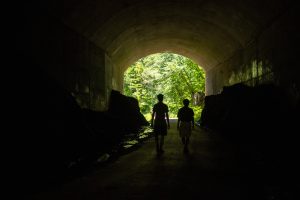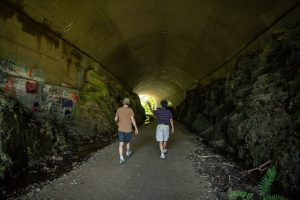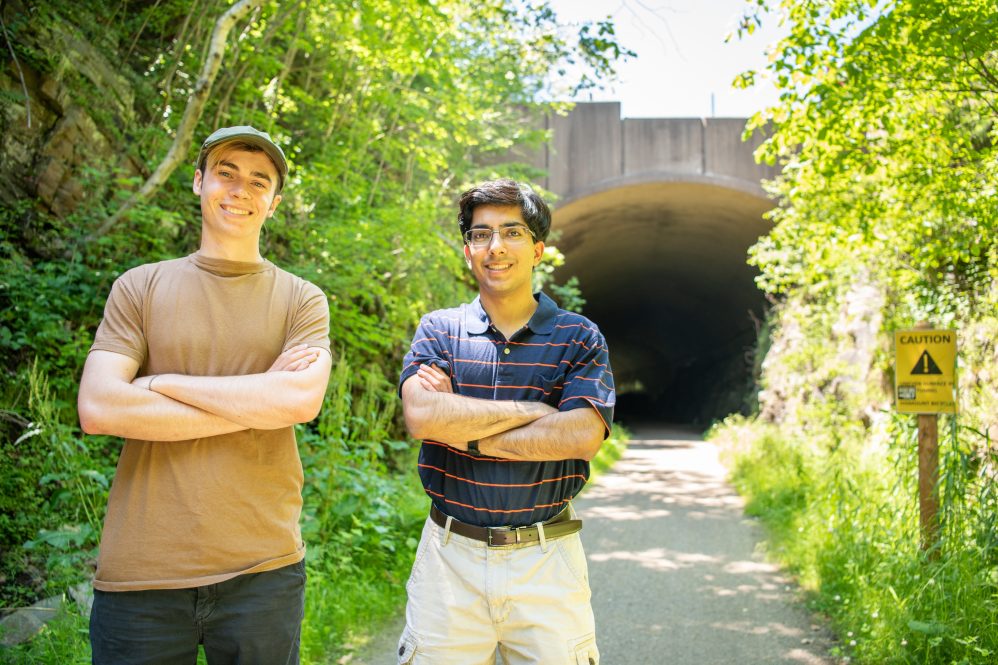If you’re going to traverse the Hop River Trail through Bolton Notch, then your path will lead you through the Tunnel: an imposing 30-foot-tall arched edifice of concrete, the entire length lined with sharp, craggy rock outcroppings.
Trenches filled with water run on either side of the massive passageway’s rutted bare-earth path, while noisy cars and trucks drive on the highway overhead. The slight curve of the daunting 800-foot-long structure means that, even on the sunniest days, the center of the tunnel is at times engulfed in complete and total darkness.
“We have had collisions inside the tunnel, where people just didn’t see each other until they were on top of each other,” say Barbara Amodio and Sylvia Ounpuu. Amodio is the founder of Bike Walk Bolton, a volunteer organization that advocates for safe, practical, and accessible options for pedestrians, cyclists, and those with mobility challenges in the town of Bolton. She and Ounpuu serve as the co-chairs of the group.
“The Hop River Trail is one of our major resources for biking and hiking and walking,” they say, “and we’ve always known that the tunnel presented a problem, especially for people new to using bikes on a trail; for older people who might have glaucoma or other eye problems; and for young children, who are petrified to go through.”
But that’s going to change, as efforts to improve safety and accessibility within the infamous tunnel are underway, thanks to the dedication of local advocates – and the work of two UConn undergraduate students, who planned out a feasible solution to this persistent, 800-foot problem.
“We Just Couldn’t Get Any Traction On It”
The Hop River Trail is part of the East Coast Greenway – a bicycle and pedestrian pathway that winds through 15 states and 450 communities, spanning 3,000 miles from Florida to Maine.
The trail itself is 20.2 miles long and winds through the eastern Connecticut towns of Manchester, Vernon, Bolton, Coventry, Andover, Colombia, and Willimantic – the Bolton-to-Andover section of the trail is 13 round-trip miles of off-road pathways used extensively by local walkers, hikers, and bicyclists as well as adventurers exploring the greater Greenway system.
Use of Connecticut’s vast network of trails has only gone up in recent years, especially during the COVID-19 pandemic. A grant-purchased infrared trail counter installed on the Bolton section of the Hop River Trail recorded 86,255 users in 2021, with an average of 222 people using the trail per day, according to the Connecticut Trail Census.
But surveys of trail users conducted in 2019 pointed to one persistent and glaring issue on the Bolton section of trail: One in six survey respondents specifically requested lighting in the tunnel as an area in need of improvement.
“The surveys confirmed our belief that traveling through that tunnel was a problem,” say Amodio and Ounpuu. “But we just couldn’t get any traction on it. We knew it was going to be an expensive project, and nobody in town seemed interested. And nobody even really knew who was responsible for it.”
Amodio and Bike Walk Bolton would eventually learn that the Connecticut Department of Transportation owned the tunnel itself, while the Connecticut Department of Energy and Environmental Protection was responsible for the pathway through it – but that knowledge didn’t surface until UConn came into the picture.

“A UConn Hallmark”
“Combining community projects with curriculum, with scholarship, and with research creates this intentional pathway for students to reinforce and validate important pieces of their education,” says Julia Yakovich, UConn’s director of Service Learning and the associate director of the Office of Outreach and Engagement. “It reaches different places of their brain where they can reflect on things that are happening both in the curriculum and in reality.”
In her role, Yakovich networks with community partners, helping them identify areas where they might need assistance and where UConn students and faculty can partner to offer help – whether it’s engineering students fixing an historic clock tower in Hartford or a psychology graduate student helping an urban agriculture and sustainability organization maintain hives of honeybees.
Yakovich also works with UConn faculty looking to incorporate Service Learning into formal coursework and to offer unique life-transformative educational experiences to their students that go far beyond the classroom.
“With Service Learning specifically, classes include reflection, which creates a dynamic within the student where they’re able to identify trajectories for their career and their life – they get to reflect on how they treat others, what’s happening inside of them at that time, and it helps to guide them in the long run,” says Yakovich. “Seeing themselves with the community, and in the community, and doing transformative activities, gives them this higher-level education that could be, and can be, and will be, a UConn hallmark.”
Unable to get traction on their tunnel lighting project, the volunteer members of Bike Walk Bolton turned to Yakovich – one member knew her from another successful UConn Service Learning project where students worked on a solar-powered trailer for the Hartford Marathon Foundation. And Yakovich then turned to Anthropology 3340, Culture and Conservation, taught by Assistant Professor Eleanor Shoreman-Ouimet.
A high-level, honors, Service Learning course – that also allows undergraduate students to fulfill their general education environmental literacy, or “E,” requirement – Anthropology 3340 offers students a theoretical deep-dive on human-environmental interaction, ethics, climate change, disasters, environmental justice, and health.
But it also includes an applied aspect, where students engage with a community partner or the broader campus community to try to implement some of what they are learning – to educate, to advocate, or to take environmental action.
Seeing themselves with the community, and in the community, and doing transformative activities, gives them this higher-level education that could be, and can be, and will be, a UConn hallmark. — Julia Yakovich, Director of Service Learning
“It doesn’t feel quite right to talk about conservation and environmental degradation and climate change and sit in a classroom,” says Shoreman-Ouimet. “Students are really eager not only to get out and fix something, but also to spread awareness, and so this course offers them the opportunity to take on these projects where they can make a difference – it’s not just, ‘here is my final paper or assignment.’ It’s really working with community members, working with libraries, working with schools, working with campus initiatives. They get to do stuff, and if all goes well, at the end they’ve opened someone’s eyes to something.”
As an honors-level course, it does tend to draw a population of really ambitious students, Shoreman-Ouimet noted. But the two undergraduates who took on the Hop River Trail tunnel project took the goals of the course, and of Service Learning, to a new level.
“It is rare to have a student group that has the time management skills and the communication skills and the staying power to get something started early enough that they can actually accomplish something in the course of a semester,” she says. “But these two had an incredible work ethic and energy and enthusiasm, and their communication skills are really impressive. They were dealing with volunteers. They were dealing with engineers. They were dealing with Eversource. They were dealing with University officials. And they did a beautiful job.”
“I Got Inspired”
“When you first hear about the tunnel you’re like, ‘Oh, it can’t be too bad, right? It’s only a tunnel,’” says Sumeet Kadian ’23 (CLAS). “But we’re talking about a tunnel that trains used to go through. It curves around the end. It’s hard to see light when you enter. You would think that your eyes can adjust quickly, but they don’t. You just walk in, and immediately it’s pitch black.”
Kadian and fellow rising senior Robert Avena ’23 (ENG) have known each other since the third grade. They’re both from East Lyme, they went to high school together, and they were roommates during their first year at UConn.
Though they’re close friends, their academic paths don’t often cross: Kadian is a dual degree student, studying molecular and cell biology and healthcare and society, an individualized major, with the goal of one day attending medical school and becoming a physician. Avena – a mechanical engineering student – is planning to attend graduate school for systems engineering.
But in that first year, Kadian found a general education course that would meet both of their “E” general education requirements – Anthropology 3340.
“I kind of dragged Rob into this course,” Kadian says. “This is the one course we have taken together, and it was great. It ended up being a really fun course, very rewarding.”
Neither Avena nor Kadian had ever conducted a feasibility study. They knew nothing about tunnels or lighting systems or navigating the complications that regularly arise when working with government agencies. But they were intrigued by the proposal from Shoreman-Ouimet about taking on the Hop River Trail tunnel project for their Service Learning course component.
“We asked her to learn more about it,” says Avena, “and it ended up being a good project for us to do.”
“I got inspired,” says Kadian, “because the Hop River Trail tunnel is part of the East Coast Greenway, which really promotes sustainable living, promotes biking, and I’ve always been a huge advocate for preventative health and health care – this fits really well with improving sustainability as well as improving people’s lifestyles. So, it was a combination of making sure that people can stay healthy while also being safe when they do so.”
They started out just by asking questions – lots of questions – and their approach instantly impressed Amodio and the volunteer members of Bike Walk Bolton. In February 2020 – right before the onset of the COVID-19 pandemic – the volunteer group, Avena, and Kadian held an initial meeting about the project at Bolton Town Hall.
I kind of dragged Rob into this course. This is the one course we have taken together, and it was great. It ended up being a really fun course, very rewarding. — Sumeet Kadian '23
“We invited stakeholders to meet with us. All came,” says Amodio. “I think there were two from DOT, two from DEEP, two from the town of Bolton, the head of Bike Walk Connecticut, the East Coast Greenway, and ourselves, Bike Walk Bolton, all at the table. And I mean, these guys – I can’t believe that they could have been freshmen. They just took command of everyone there. They were so impressive and just so well thought out.”
After that first meeting, Avena and Kadian set out to learn as much as they could about the site, the trail, and the possible options for adding lighting to the tunnel.
They took measurements and photographs. They reached out to engineers at both private companies as well as the DOT. They learned about the availability of electrical connections already in place in the area, researched solar tubes and panels, uncovered differences in and recommendations about lighting temperatures, and examined lighting systems already in place on other tunnels, like a smaller trail tunnel in nearby Andover.
“Rob and I looked at all possibilities,” says Kadian. “We were looking at solar panels, because we were promoting sustainability, but we learned that might not be the best option. We learned that, even when promoting sustainability, there are some drawbacks in order to make it a cost-effective solution as well the most efficient solution.”
They secured photometric calculations of the tunnel to help guide decision making. They calculated potential kilowatt-hour electric usage for a potential lighting system. They identified potential funding sources to not only pay for the installation of their recommended lighting system – ten hard-wired, ceiling-mounted, LED units – but also to help cover the ongoing electric costs, which they estimated at approximately $350 a month if the lights were to run 24 hours a day.
“This was right at the beginning of the pandemic, but the pandemic did not deter us from our mission” says Avena. “We were committed to this project. We wanted to see it go through regardless of circumstances going on. We wanted to really make sure that we could fulfill it to its completion. There were a lot of phone calls and a lot of emails, and the pandemic might have actually played into the fact that pretty much everybody responded to us. A lot of people were really interested in helping. It was a surprisingly positive reception.”
The result of their efforts is a 33-page report detailing their findings and their recommendations for installing lighting in the tunnel.
“Essentially what we said is that lighting the tunnel is absolutely feasible,” says Kadian, “and primarily that feasibility comes down to a lot of things. But first and foremost is the safety of the occupants in the tunnel.”

“If People Can Help You, They Will”
Plans are now in the works to finally install a lighting system in the tunnel, much to the delight of the local advocates of Bike Walk Bolton – and to the credit of Kadian and Avena.
“The feasibility study prepared by the UConn students providing a comprehensive look at lighting options in the tunnel was high-quality and impactful,” DOT spokesperson Josh Morgan said in a statement. “The students were eager, ambitious, and self-starters. Although CTDOT provided help where needed, the students took the initiative and lead on this project. They were a pleasure to work with, and we are so appreciative of their effort and willingness to prepare this study.”
“Without their work, we would not have come along as far as we have come,” says Amodio. “Right now, it’s with DOT and DEEP, and almost set to go to the electric company.”
The positive experience also led to a second partnership with Bike Walk Bolton, UConn Service Learning, and Anthropology 3340 – rising senior Connor Rickermann ’23 (ENG/CLAS), a dual degree computer science engineering and cognitive sciences major, worked with the group on an economic impact project, helping to collect data on how people use the Hop River Trail, what users like and dislike about the trail, what amenities and commodities exist along the trail, and how awareness can be heightened to the benefit of both trail users and local businesses.
“The recommendations that I ended up making with respect to the activity of trailgoers – be those people who are regular walkers, or people who are tourists of sorts – the idea is that some more resources should be available to them so that they’re more aware of the businesses that surrounds the Hop River Trail system,” Rickermann says. “Because oftentimes when you come at the intersections, it’s not very obvious where the commodities are or what’s even available to you in the first place. It’s easy enough to just look up on your phone where stuff is, but if you’re not looking for that sort of thing to begin with, or you’re not even aware of it, then you’re probably not going to go out of your way to search for it.”
Amodio encourages other organizations that have identified a problem, but aren’t sure how to get to a solution, to consider UConn and Service Learning as a partnership option – and “to call Julia.”
“Julia will find someone for them that this fits their needs,” she says, “because their needs aren’t always going to be the same.”
“Julia comes back to the class year after year and introduces them to projects, introduces them to the community members, and helps keep that relationship going,” Shoreman-Ouimet agrees. “She’s just involved from A-to-Z. That not only provides more support for me and the students, but also for the community members. I’m really grateful for Julia’s energy in all of these efforts. And I think the students really are, too, because if it wasn’t for that element, it would make these community communications a lot harder. I think she provides opportunities for students that, as faculty, we wouldn’t necessarily be able to maintain.”
For Avena and Kadian, the experience of working with their community partner taught them to ask questions and to not be afraid of stepping outside of their comfort zones.
“I think learning to not be afraid to reach out and to really just see if anybody is going to respond is something that was kind of hard for me at first, but that proved to be really helpful for this project,” says Avena, “and it proved to be helpful in my future, too. When I wanted to go do research, I had to reach out to professors, which was kind of a scary task. Having done this project really helped me to just specifically state what I’m looking for, and I found that if people can help you, they will.”
“There’s so much more out there in the world than you think there is,” Kadian says. “Once you give yourself the opportunity, you might find something you’re really passionate about. For me, it was through this project, really, that I became quite interested in preventative medicine and living sustainably and living a healthy lifestyle and doing so safely, through something like lighting a tunnel. So, never be afraid to explore, and you’ll be amazed at the connections you can make.”



